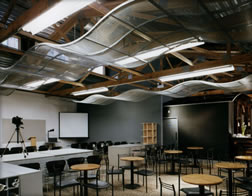For almost 20 years, Archeworks has been a design educator working collaboratively with Chicago communities in the advancement of sustainable urban design.
Originally founded by internationally known architect and former director of the University of Illinois Chicago School of Architecture Stanley Tigerman and award-winning designer Eva Maddox in 1994. Archeworks is comprised of students with a broad range of interests from a span of professional careers; their post-education program is unlike any other offering a certificate in sustainable urban design.
“It is a field-based, experimental, team-based learning program in collaboration with community partners and other stakeholders,” said Susanne Schnell executive director of Archeworks. “We use a variety of different design methods and we emphasize a human center and participatory approach that’s very interactive. It’s more of an action research program that looks at inquirybased learning, and it’s very much about the team becoming self-directed and learning from the actual context of the design challenge.”
Their projects range from educational programs, exploring universal design and sustainable food systems, community health, micro-enterprise, eldercare, homelessness and many more. Their mission is simple, “Design shapes the way we live. The fewer resources communities and individuals have, the more they need great design solutions to enhance the quality of life.” The Chicago Expander is the newest public series at Archeworks, led by two internationally influential design brains Iker Gil and Antonio Petrov. According to Archeworks, The Chicago Expander “Aims to spatialize the formation of Chicago as a larger geographic entity and recast the city and its region as a spatial model.”
Director of MAS Studio, Gil is an architect, urban designer and professor at ITT College of Architecture. Currently teaching at the University of San Antonio, Petrov received his doctoral degree in history and theory of architecture, urban vision and cultural studies from Harvard University. Petrov is currently editor-in-chief of the Harvard GSD publication “New Geographies.”
Gil and Petrov through the Chicago Expander have brought together scholars, scientists, theorists and practitioners from Chicago and around the world. Through researching regionalism and urbanism as well as other critical thinking elements these workshops and lectures create the opportunity for more public discussion.
“What we wanted to do when we started talking about a program for Archeworks was to position Chicago in a changing world the way we felt different research attempts within the city haven’t done,” said Petrov. “So, we were thinking how can we look at the city and understand it better within its own context.”
Beginning the Expander lectures series, Harvard Professor of Urban Theory Neil Brenner used cotemporary urban ideologies as a platform for “The Urban Age in Question,” and the most recent lecture, “The World According to Architecture” featured Aga Khan Professor of Landscape Architecture and Urbanism in Muslim Societies Hashim Sarkis. The Expander workshops thus far have explored topics: Energy and Economy, Agency and Transportation. “I think that it is a very relevant subject, and I think that it is very timely,” said Petrov. “Especially because of what is happening all over the world, in Brazil and in Turkey. You know, where we kind of our fighting for new rights in public space, and there are all these ways to start looking at the city and where it is evolving.
Despite their international work in the design world, Petrov and Gil are extremely intrigued by the city of Chicago, “The position of Chicago is very interesting locally, but also in the US and internationally,” said Gil. “In the last year alone there has been an lot of interest in the metropolitan areas, and then more recently interest in the area around the Great Lakes. For me, what is also really interesting is Chicago is on the hinge of many systems depending on how we look at them. So there is the Great Lakes, but it is also the mark of the Mississippi, so it’s important for its location and allows the possibility of having many more relations.”
Focusing on the exploration of the relationships not necessarily visible, “We should be paying more attention to them,” said Gil. “I think that for me it’s really interesting because Chicago is in a really great position, but then at the same time nobody has paid as much attention to it as other areas in the US. It is important to mention is that it is a society of the collaborative spirit we are really exercising. It is really all about collaboration and expanding, not just perceptions and views but also expanding the agency of urban design and architecture and how other disciplines can enrich what we do. In the same way, we hope that our work can inspire other disciplines.” Looking at socially engaged design, Archeworks programs and projects morph and adapt each term with current public interests. “Archeworks has a very unique role to play,” said Schnell, “We are both outside the academy of traditional university and we have a lot of flexibility in our programming. It’s about really going deeper into the nature of the problem and looking at different systems and root sources and root causes and other solutions that not might not necessarily be discovered or uncovered … we believe we are filling a gap that is not necessarily provided in a graduate program.”
The next project in The Chicago Expander series will be an public exhibit showcasing all of their research thus far coming this fall. For more information about Archeworks programs or to enroll in their Fall 2013 class check out here
Article Written By Emma Watson


